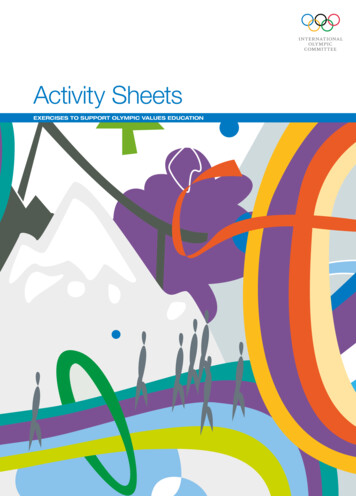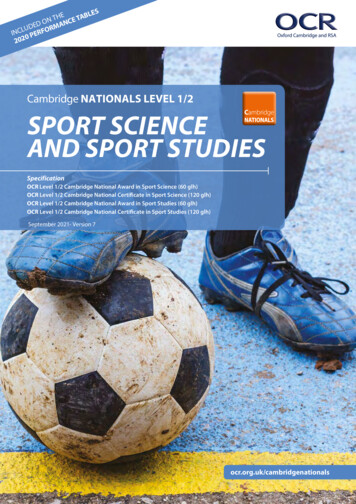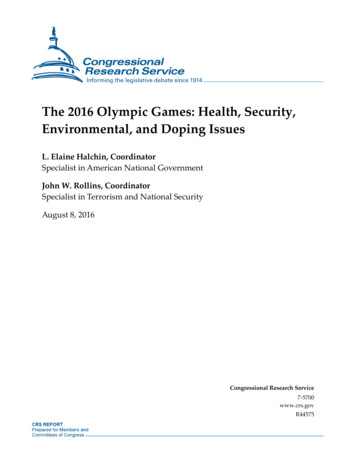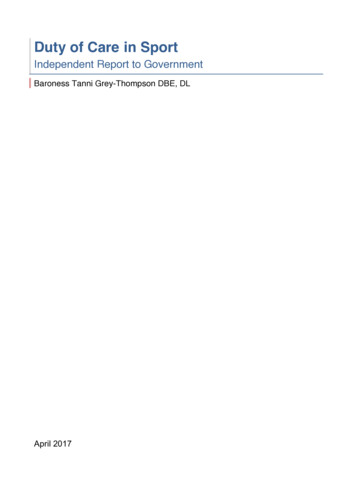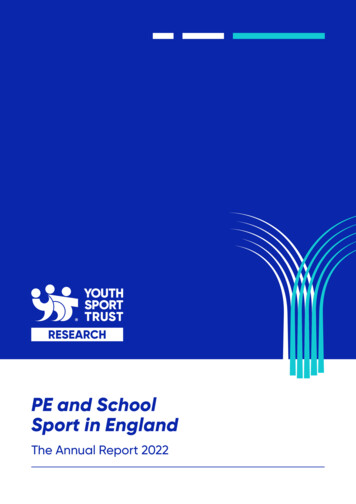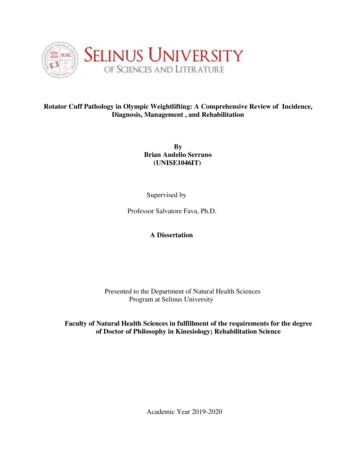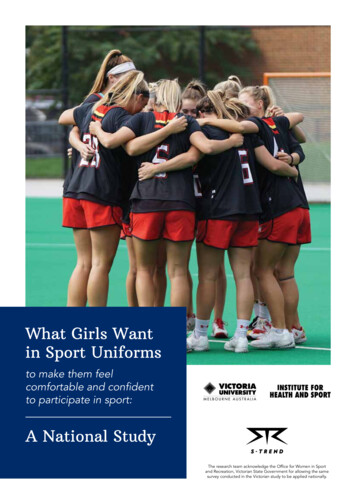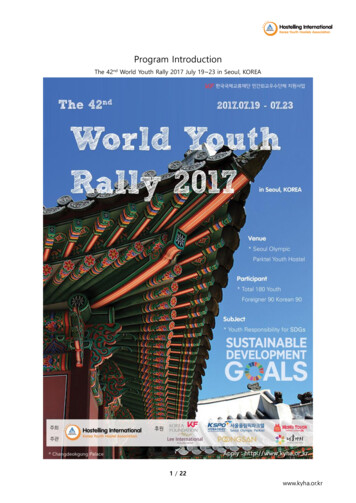
Transcription
BIOMECHANICS IN SPORTPERFORMANCE ENHANCEMENT ANDINJURY PREVENTIONVOLUME IX OF THE ENCYCLOPAEDIA OF SPORTS MEDICINEAN IOC MEDICAL COMMISSION PUBLICATIONIN COLLABORATION WITH THEINTERNATIONAL FEDERATION OF SPORTS MEDICINEEDITED BYVLADIMIR M. ZATSIORSKY
BIOMECHANICS IN SPORT
IOC MEDICAL COMMISSIONSUB-COMMISSION ON PUBLICATIONS IN THE SPORT SCIENCESHoward G. Knuttgen PhD (Co-ordinator)Boston, Massachusetts, USAFrancesco Conconi MDFerrara, ItalyHarm Kuipers MD, PhDMaastricht, The NetherlandsPer A.F.H. Renström MD, PhDStockholm, SwedenRichard H. Strauss MDLos Angeles, California, USA
BIOMECHANICS IN SPORTPERFORMANCE ENHANCEMENT ANDINJURY PREVENTIONVOLUME IX OF THE ENCYCLOPAEDIA OF SPORTS MEDICINEAN IOC MEDICAL COMMISSION PUBLICATIONIN COLLABORATION WITH THEINTERNATIONAL FEDERATION OF SPORTS MEDICINEEDITED BYVLADIMIR M. ZATSIORSKY
2000 International Olympic CommitteePublished byBlackwell Science LtdEditorial Offices:Osney Mead, Oxford OX2 0EL25 John Street, London WC1N 2BL23 Ainslie Place, Edinburgh EH3 6AJ350 Main Street, MaldenMA 02148-5018, USA54 University Street, CarltonVictoria 3053, Australia10, rue Casimir Delavigne75006 Paris, FranceOther Editorial Offices:Blackwell Wissenschafts-Verlag GmbHKurfürstendamm 5710707 Berlin, GermanyBlackwell Science KKMG Kodenmacho Building7–10 Kodenmacho NihombashiChuo-ku, Tokyo 104, JapanFirst published 2000Set by Graphicraft Limited, Hong KongPrinted and bound in Great Britainat the University Press, CambridgeThe Blackwell Science logo is atrade mark of Blackwell Science Ltd,registered at the United KingdomTrade Marks RegistryPart title illustrationby Grahame BakerThe right of the Authors to beidentified as the Authors of this Workhas been asserted in accordancewith the Copyright, Designs andPatents Act 1988.All rights reserved. No part ofthis publication may be reproduced,stored in a retrieval system, ortransmitted, in any form or by anymeans, electronic, mechanical,photocopying, recording or otherwise,except as permitted by the UKCopyright, Designs and Patents Act1988, without the prior permissionof the copyright owner.A catalogue record for this titleis available from the British LibraryISBN 0-632-05392-5Library of CongressCataloging-in-publication DataBiomechanics in sport: performanceimprovement and injury prevention /edited by Vladimir M. Zatsiorsky.p.cm.—(Volume IX ofthe Encyclopaedia of sports medicine)“An IOC Medical Commissionpublication in collaboration with theInternational Federation of SportsMedicine.”ISBN 0-632-05392-51. Sports—Physiological aspects.2. Human mechanics. 3. Sportsinjuries. I. Zatsiorsky, Vladimir M.,1932– II. IOC Medical Commission.III. International Federation of SportsMedicine. IV. Encyclopaedia of sportsmedicine; v. 10RC1235 .B476 2000617.1′027—dc2199-054566distributorsMarston Book Services LtdPO Box 269Abingdon, Oxon OX14 4YN(Orders: Tel: 01235 465500Fax: 01235 465555)USABlackwell Science, Inc.Commerce Place350 Main StreetMalden, MA 02148-5018(Orders: Tel: 800 759 6102781 388 8250Fax: 781 388 8255)CanadaLogin Brothers Book Company324 Saulteaux CrescentWinnipeg, Manitoba R3J 3T2(Orders: Tel: 204 837 2987)AustraliaBlackwell Science Pty Ltd54 University StreetCarlton, Victoria 3053(Orders: Tel: 3 9347 0300Fax: 3 9347 5001)For further information onBlackwell Science, visit our website:www. blackwell-science.com
ContentsPart 2: LocomotionList of Contributors, viiForewords, ix7Factors Affecting Preferred Rates of Movementin Cyclic Activities, 143P.E. MARTIN, D.J. SANDERSON ANDB.R. UMBERGER8The Dynamics of Running, 161K.R. WILLIAMS9Resistive Forces in Swimming, 184A.R. VORONTSOV AND V.A. RUMYANTSEVPreface, xiPart 1: Muscle Action inSport and Exercise1Neural Contributions to Changes inMuscle Strength, 3J.G. SEMMLER AND R.M. ENOKA2Mechanical Properties and Performance inSkeletal Muscles, 21W. HERZOG3Muscle-Tendon Architecture andAthletic Performance, 33J.H. CHALLIS4Eccentric Muscle Action in Sport andExercise, 56B.I. PRILUTSKY5Stretch–Shortening Cycle ofMuscle Function, 87P.V. KOMI AND C. NICOL6Biomechanical Foundations of Strength andPower Training, 103M.C. SIFF10Propulsive Forces in Swimming, 205A.R. VORONTSOV AND V.A. RUMYANTSEV11Performance-Determining Factors inSpeed Skating, 232J.J. DE KONING AND G.J. VAN INGEN SCHENAU12Cross-Country Skiing: Technique, Equipmentand Environmental Factors AffectingPerformance, 247G.A. SMITHPart 3: Jumping andAerial Movement13Aerial Movement, 273M.R. YEADON14The High Jump, 284J. DAPENAv
vicontents15Jumping in Figure Skating, 312D.L. KING16Springboard and Platform Diving, 326D.I. MILLER17Determinants of Successful Ski-JumpingPerformance, 349P.V. KOMI AND M. VIRMAVIRTAPart 5: Injury Prevention andRehabilitation2425Principles of Throwing, 365R. BARTLETT19The Flight of Sports Projectiles, 381M. HUBBARD20Javelin Throwing: an Approach toPerformance Development, 401K. BARTONIETZ21Shot Putting, 435J. LANKA2223Hammer Throwing: Problems andProspects, 458K. BARTONIETZHitting and Kicking, 487B.C. ELLIOTTMusculoskeletal Loading During Landing, 523J.L. MCNITT-GRAY26Sport-Related Spinal Injuries and TheirPrevention, 550G .- P . B R Ü G G E M A N N27Impact Propagation and its Effects on theHuman Body, 577A.S. VOLOSHIN28Neuromechanics of the Initial Phase ofEccentric Contraction-InducedMuscle Injury, 588M.D. GRABINERPart 4: Throwing and Hitting18Mechanisms of Musculoskeletal Injury, 507R.F. ZERNICKE AND W.C. WHITINGPart 6: Special Olympic Sports29Manual Wheelchair Propulsion, 609L.H.V. VAN DER WOUDE, H.E.J. VEEGER ANDA.J. DALLMEIJER30Sports after Amputation, 637A.S. ARUINIndex, 651
List of ContributorsA.S. ARUIN PhD, Motion Analysis Laboratory,Rehabilitation Foundation Inc., 26W171 Roosevelt Road,Wheaton, IL 60189, USAR.M. BARTLETT PhD, Sport Science ResearchInstitute, Sheffield Hallam University, Collegiate Hall,Sheffield S10 2BP, UKK. BARTONIETZ PhD, Olympic Training CenterRhineland-Palatinate/Saarland, Am Sportzentrum 6, 67105Schifferstadt, GermanyG.-P. BRÜGGEMANN PhD, DeutscheSporthochschule Köln, Carl-Diem-Weg 6, 50933 Köln,GermanyJ.H. CHALLIS PhD, Biomechanics Laboratory,Department of Kinesiology, 39 Rec. Hall, The PennsylvaniaState University, University Park, PA 16802-3408, USAM.D. GRABINER PhD, Department of BiomedicalEngineering, The Cleveland Clinic Foundation, 9500 EuclidAvenue, Cleveland, Ohio 44195, USAW. HERZOG PhD, Faculty of Kinesiology, TheUniversity of Calgary, 2500 University Drive NW, Calgary,Alberta T2N 1N4, CanadaM. HUBBARD PhD, Department of Mechanical andAeronautical Engineering, University of California, Davis,CA 95616, USAG.J. van INGEN SCHENAU PhD, Institutefor Fundamental and Clinical Human Movement Sciences,Faculty of Human Movement Sciences, Vrije UniversiteitAmsterdam, The Netherlands (Professor G.J. van IngenSchenau unfortunately passed away during the productionof this volume.)D.L. KING PhD, Department of Health and HumanA.J. DALLMEIJER PhD, Institute for Fundamentaland Clinical Human Movement Sciences, Faculty of HumanMovement Sciences, Vrije Universiteit Amsterdam, TheNetherlandsJ. DAPENA PhD, Biomechanics Laboratory,Department of Kinesiology, Indiana University,Bloomington, IN 47405, USAB. ELLIOTT PhD, The Department of HumanMovement and Exercise Science, The University of WesternAustralia, Nedlands, Western Australia 6907, AustraliaDevelopment, Montana State University, Bozeman, MT59717, USAP.V. KOMI PhD, Neuromuscular Research Centre,Department of Biology of Physical Activity, University ofJyväskylä, 40351 Jyväskylä, FinlandJ.J. de KONING PhD, Institute for Fundamental andClinical Human Movement Sciences, Faculty of HumanMovement Sciences, Vrije Universiteit Amsterdam, TheNetherlandsJ. LANKA PhD, Department of Biomechanics, LatvianR.M. ENOKA PhD, Department of Kinesiology andApplied Physiology, University of Colorado, Boulder, CO80309-0354, USAAcademy of Sport Education, Brivibas 333, Riga LV-1006,Latviavii
viiilist of contributorsP.E. MARTIN PhD, Exercise and Sport ResearchInstitute, Arizona State University, Tempe, Arizona 85287,USAH.E.J. VEEGER PhD, Institute for Fundamental andClinical Human Movement Sciences, Faculty of HumanMovement Sciences, Vrije Universiteit Amsterdam, TheNetherlandsJ.L. McNITT-GRAY PhD, Biomechanics ResearchLaboratory, Department of Exercise Sciences, University ofSouthern California, Los Angeles, CA 90089-0652, USAM. VIRMAVIRTA PhLic, Neuromuscular ResearchCentre, Department of Biology of Physical Activity,University of Jyväskylä, 40351 Jyväskylä, FinlandD.I. MILLER PhD, School of Kinesiology, Faculty ofHealth Sciences, University of Western Ontario, London,Ontario, N6A 3K7, CanadaC. NICOL PhD, UMR 6559 Mouvement & Perception,CNRS-Université de la Méditerranée, Faculté des Sciencesdu Sport, 163, avenue de Luminy CP 910, F-13288 MarseilleCedex 9, FranceA.S. VOLOSHIN PhD, Department of MechanicalEngineering and Mechanics, Institute for MathematicalBiology and Biomedical Engineering, Lehigh University,Bethlehem, PA 18015, USAA.R. VORONTSOV PhD, Department ofSwimming, Russian State Academy of Physical Culture, 4Sirenevy Boulevard, Moscow 105122, Russian FederationB.I. PRILUTSKY PhD, Center for Human MovementStudies, Department of Health and Performance Sciences,Georgia Institute of Technology, Atlanta, GA 30332, USAW.C. WHITING PhD, Department of Kinesiology,California State University, Northridge, 18111 NordhoffStreet, Northridge, CA 91330-8287 USAV.A. RUMYANTSEV PhD, Department ofSwimming, Russian State Academy of Physical Culture, 4Sirenevy Boulevard, Moscow 105122, Russian FederationD.J. SANDERSON PhD, School of Human Kinetics,University of British Columbia, Vancouver, BritishColumbia, V6T 1Z1, CanadaK.R. WILLIAMS PhD, Department of ExerciseScience, University of California, Davis, CA 95616, USAL.H.V. van der WOUDE PhD, Institute forFundamental and Clinical Human Movement Sciences,Faculty of Human Movement Sciences, Vrije UniversiteitAmsterdam, The NetherlandsJ.G. SEMMLER PhD, Department of Kinesiology andApplied Physiology, University of Colorado, Boulder, CO80309-0354, USAM.R. YEADON PhD, Department of Sports Science,Loughborough University, Ashby Road, Loughborough,LE11 3TU, UKM.C. SIFF PhD, School of Mechanical Engineering,University of the Witwatersrand, South AfricaG.A. SMITH PhD, Biomechanics Laboratory,Department of Exercise and Sport Science, Oregon StateUniversity, Corvallis, OR 97331, USAB.R. UMBERGER MS, Exercise and Sport ResearchInstitute, Arizona State University, Tempe, Arizona 85287,USAV.M. ZATSIORSKY PhD, Department ofKinesiology, The Pennsylvania State University, UniversityPark, PA 16802, USAR.F. ZERNICKE PhD, Faculty of Kinesiology,University of Calgary, 2500 University Drive NW, Calgary,AB, T2N 1N4, Canada
ForewordsOn behalf of the International Olympic Committee,I welcome the publication of Volume IX in the IOCMedical Commission’s series, The Encyclopaedia ofSports Medicine.Citius, Altius, Fortius is our motto, which suggests the successful outcome to which all athletesaspire.The role of the Olypmic movement is to providethese athletes with everything they require to attainthis goal.Biomechanics contributes to this end, throughresearch into correct movement and the subsequentimprovement in training equipment and techniques,by always keeping in view ways of improving performance while maintaining absolute respect for thehealth of the athletes.Juan Antonio SamaranchPrésident du CIOMarqués de SamaranchIn the area of sports science, the last 20 years havewitnessed the development of a remarkable numberof advances in our knowledge of skill performance,equipment design, venue construction, and injuryprevention based on the application of biomechanical principles to sport.The accumulation of this wealth of biomechanical knowledge demanded that a major publicationbe produced to gather, summarize, and interpretthis important work. It therefore became a logicaldecision to add ‘biomechanics’ to the list of topicareas to be addressed in the IOC Medical Commission’s series, The Encyclopaedia of Sports Medicine.Basic information is provided regarding skeletalmuscle activity in the performance of exercise andsport; specific sections are devoted to locomotion,jumping and aerial movement, and throwing; andparticular attention is given to injury prevention,rehabilitation, and the sports of the Special Olympics.An effort was made to present the information in aformat and style that would facilitate its practicalapplication by physicians, coaches, and other professional personnel who work with the science ofsports performance and injury prevention.This publication will most certainly serve as areference and resource for many years to come.Prince Alexandre de MerodeChairman, IOC Medical Commissionix
PrefaceThe essence of all sports is competition in movement skills and mastership. Sport biomechanics isthe science of sport (athletic) movements. Becauseof that, if nothing else, it is vital for sport practice.For decades, athletic movements have been performed and perfected by the intuition of coachesand athletes. We do have evidence in the literaturethat some practitioners understood the laws ofmovement even before Sir Isaac Newton describedthem. It was reported that Sancho Panza, when hesaw his famous master attacking the windmills, toldsomething about Newton’s Third Law: he knew thatthe windmills hit his master as brutally as he hitthem. Although it is still possible to find people whobelieve that intuitive knowledge in biomechanics issufficient to succeed, it is not the prevailing attitudeanymore. More fundamental lore is necessary. Ihope this book proves that.It was a great honour for me to serve as an editorof the volume on Biomechanics in Sport: PerformanceEnhancement and Injury Prevention. The book isintended to be a sequel to other volumes of theseries of publications entitled Encyclopaedia of SportsMedicine that are published under the auspices of theMedical Commission of the International OlympicCommittee. The main objective of this volume isto serve coaches, team physicians, and seriousathletes, as well as students concerned with theproblems of sport biomechanics.Editing the volume was a challenging task: Thefirst challenge was to decide on the content of thebook. The problems of sport biomechanics can beclustered in several ways: General problems of sport biomechanics (e.g.muscle biomechanics, eccentric muscle action). Given sport movements (high jump) and sports(biomechanics of diving). Parts of the human body (biomechanics of spine). Blocks (constitutional parts) of natural athleticactivities (athlete in the air, biomechanics of landing).Each approach has its own pros and cons; it alsohas limitations. For instance, the number of eventsin the programme of Summer Olympic Gamesexceeds 200. Evidently, it is prohibitive to have 200chapters covering individual events. After consideration, the plan of the book was selected andapproved by the IOC Publications Advisory Committee (it is my pleasure to thank the Committeemembers for their support and useful advice).The book is divided into the following six parts.1 Muscle action in sport and exercise: This sectionis devoted to general problems of biomechanics ofathletic movements.2 Locomotion: After the introductory chapter,which covers material pertinent to all cycliclocomotions, the following sports are described:running, cycling, swimming, cross-country skiing,and skating.3 Jumping and aerial movement: The openingchapter in this section highlights the biomechanicsof aerial motion, while other chapters address highjumping, ski jumping, jumping in figure skatingand diving.4 Throwing and hitting: The section starts withtwo chapters that explain the basic principles ofthrowing and the aerodynamic aspects of the flightxi
xiiprefaceof projectiles, respectively. Individual sports are shotputting, javelin throwing and hammer throwing.5 Injury prevention and rehabilitation: Each chapter in this section addresses the problems that arepertinent to many sports.6 Special Olympics sports: Biomechanics of wheelchair sports and sport for amputees are discussed.Many recognized scholars participated in thisproject. The authors of the volume, 37 in total, haveunique areas of expertise and represent 11 countries, including Austria, Canada, Finland, Germany,Holland, Latvia, Russia, Singapore, South Africa,United Kingdom and USA. Geography, however,did not play a substantial role in determining theauthors. Their expertise did. The book containschapters contributed by scholars who have established themselves as prominent world experts intheir particular research or applied fields. To theextent that certain areas of sport biomechanicsand eminent biomechanists have been omitted,apologies are offered. Evidently, a line had to bedrawn somewhere. Outstanding experts are, as arule, overworked people. Appreciation is acknowledged to the authors of this book who gave of theirprecious time to contribute to this endeavour. I amgrateful to all of them.Vladimir M. ZatsiorskyProfessorDepartment of Kinesiology,The Pennsylvania State University2000dedicationA distinguished colleague and friend of the international biomechanics community, Dr. Gerrit Jan van Ingen Schenau, passed away duringthe production of this volume. During his academic career, Professorvan Ingen Schenau conducted numerous studies of human performance and contributed dozens of publications to the literature ofhuman biomechanics and sport. One of his last projects can be found inthis volume, where he was a co-author of Chapter 11, PerformanceDetermining Factors in Speed Skating.Participation of Professor van Ingen Schenau in international scientific activities will be sorely missed. The contributing authors and Iwish to dedicate this volume to his memory.VMZ
PART 1MUSCLE ACTION IN SPORTAND EXERCISE
Chapter 1Neural Contributions to Changes in Muscle StrengthJ.G. SEMMLER AND R.M. ENOKAIntroductionTo vary the force that a muscle exerts, the nervoussystem either changes the number of active motorunits or varies the activation level of those motorunits that have been activated. For much of theoperating range of a muscle, both processes areactivated concurrently (Seyffarth 1940; Person &Kudina 1972). Motor units are recruited sequentially and the rate at which each discharges actionpotentials increases monotonically to some maximal level. Although most human muscles comprisea few hundred motor units, the order in whichmotor units are activated appears to be reasonablystereotyped (Denny-Brown & Pennybacker 1938;Henneman 1977; Binder & Mendell 1990). For mosttasks that have been examined, motor units arerecruited in a relatively fixed order that proceedsfrom small to large based on differences in motorneurone size, which is the basis of the Size Principle(Henneman 1957). Although variation in motorneurone size per se is not the primary determinantof differences in recruitment threshold, a numberof properties covary with motor neurone size andthereby dictate recruitment order (Heckman &Binder 1993).Despite current acceptance of the Size Principle asa rubric for the control of motor unit activity (Cope& Pinter 1995), our understanding of the distribution of motor unit activity among a group of synergist muscles is more rudimentary. One prominentexample of this deficit in our knowledge is the lackof understanding of the role performed by the nervous system in the strength gains that are achievedwith physical training. When an individual participates in a strength-training programme, much ofthe increase in strength, especially in the first fewweeks of training, is generally attributed to adaptations that occur in the nervous system (Enoka 1988;Sale 1988). Because the assessment of strength inhumans involves the activation of multiple muscles,the neural mechanisms that contribute to strengthgains undoubtedly involve the coordination ofmotor unit activity within and across muscles. Nonetheless, the evidence that identifies specific neuralmechanisms is rather weak. The purpose of thischapter is to emphasize our lack of understandingof the neural mechanisms that mediate strengthgains and to motivate more systematic and criticalstudies on this topic.To accomplish this purpose, we describe the relationship between muscle size and strength, discussthe significance of specific tension, present the casefor a role of the nervous system in strength gains,and evaluate the potential neural mechanismsthat contribute to increases in strength. Despite asubstantial literature on training strategies forincreasing muscle strength, less is known aboutthe biomechanical and physiological mechanismsresponsible for the changes in performance capacity.Muscle size and strengthEach muscle fibre contains millions of sarcomeres(the force-generating units of muscle), which arearranged in series (end-to-end in a myofibril) andin parallel (side-by-side myofibrils) to one another.Theoretically, the maximum force that a muscle3
4muscle action in sport and exerciseMuscle strength (N)fibre can exert depends on the number of sarcomeres that are arranged in parallel (Gans & Bock1965). By extension, the maximum force that a muscle can exert is proportional to the number of musclefibres that lie in parallel to one another. Becauseof this association, the strength of a muscle canbe estimated anatomically by measuring its crosssectional area (Roy & Edgerton 1991). This measurement should be made perpendicular to the directionof the muscle fibres and is known as the physiologicalcross-sectional area.Despite the theoretical basis for measuring thephysiological cross-sectional area of muscle toestimate its force capacity, it is typically moreconvenient to measure the anatomical cross-sectionalarea, which is a measurement that is made perpendicular to the long axis of the muscle. This canbe accomplished by using one of several imagingtechniques (e.g. computed tomography (CT) scan,magnetic resonance imaging, ultrasound) to determine the area of a muscle at its maximum diameter. Examples of the relationship between musclestrength and anatomical cross-sectional area areshown in Fig. 1.1 (Kanehisa et al. 1994). In scle cross-sectional area (cm2)Fig. 1.1 Muscle strength varies as a function of the cross-sectional area of a muscle (adapted from Kanehisa et al. 1994).(a) Elbow flexors (r2 0.56). (b) Elbow extensors (r2 0.61). (c) Knee flexors (r2 0.17 for men [solid line] and 0.35 forwomen [dashed line]). (d) Knee extensors (r2 0.54 for men and 0.40 for women). Men are indicated with filled symbolsand women with open symbols.
muscle strengthexperiments, muscle strength was measured as thepeak force exerted on an isokinetic device at anangular velocity of about 1.0 rad · s 1, and the maximum anatomical cross-sectional area for eachmuscle group was measured with an ultrasoundmachine. Measurements were made on the elbowflexor and extensor muscles and on the knee flexorand extensor muscles of 27 men and 26 women.For the elbow flexor and extensor muscles, themen were, on average, stronger than the women,but this was due to a greater cross-sectional area(Fig. 1.1a,b). The average strength (mean SE) of theelbow flexors, for example, was 130 4 N for themen compared with 89 4 N for the women; andthe average cross-sectional area was 141 0.4 cm2for the men and 91 0.2 cm2 for the women. Thus,the normalized force (force/cross-sectional area) was9.2 N · cm–2 for men and 9.8 N · cm–2 for women. Incontrast, the differences in strength between menand women for the knee muscles (Fig. 1.1c,d) weredue to differences in both the cross-sectional areaand the normalized force (force per unit area). Forexample, the average strength for the knee extensormuscles was 477 17 N for the men and 317 15 Nfor the women, and the average cross-sectional areawas 74 2 cm2 for the men and 62 2 cm2 for thewomen. The normalized forces were 6.5 N · cm 2and 5.1 N · cm–2, respectively. The difference innormalized force is apparent by the y-axis displacement of the regression lines for the men and women(Fig. 1.1c,d). These regression lines indicate that fora cross-sectional area of 70 cm2 for the knee extensormuscles, a man could exert a force of 461 N compared with 361 N for a woman.These data demonstrate, as many others haveshown (Jones et al. 1989; Keen et al. 1994; Kawakamiet al. 1995; Narici et al. 1996), that the strength of amuscle depends at least partly on its size, as characterized by its cross-sectional area. This conclusionprovides the foundation for the strength-trainingstrategy of designing exercise programmes that maximize muscle hypertrophy, i.e. an increase in thenumber of force-generating units that are arrangedin parallel. Nonetheless, there is substantial variability in the relationship between strength and crosssectional area, which is indicated by the scatter ofthe data points about the lines of best fit in Fig. 1.1.5Some of this variability may be due to the use ofanatomical rather than physiological cross-sectionalarea as the index of muscle size. However, variationin cross-sectional area accounts for only about 50%of the difference in strength between individuals(Jones et al. 1989; Narici et al. 1996).Specific tensionThe other muscular factor that influences strength isthe intrinsic force-generating capacity of the musclefibres. This property is known as specific tension andis expressed as the force that a muscle fibre can exertper unit of cross-sectional area (N · cm–2). To makethis measurement in human subjects, segments ofmuscle fibres are obtained by muscle biopsy andattached to a sensitive force transducer that ismounted on a microscope (Larsson & Salviati 1992).Based on such measurements, specific tension hasbeen found to vary with muscle fibre types, todecrease after 6 weeks of bed rest for all fibre types,to decline selectively with ageing, and to increasefor some fibre types with sprint training (Harridgeet al. 1996, 1998; Larsson et al. 1996, 1997). For example, the specific tension of an average type IImuscle fibre in vastus lateralis was greater thanthat for a type I muscle fibre for the young andactive old adults but not for the sedentary oldadults (Table 1.1). This finding indicates that themaximum force capacity of a type II muscle fibreTable 1.1 Cross-sectional area (µm2) and specific tension(N · cm 2) of chemically skinned fibre segments from thehuman vastus lateralis muscle (Larsson et al. 1997).Cross-sectionalareaSpecific tensionSubject groupType IType IIType IType IIYoung control2820 6203840 74019 324* 3Old control3090 8702770† 74018 619 1Old active2870 6803710 157016 520* 6Values are mean SD. * P 0.001 for type I vs. type II.† P 0.001 for old control vs. young control and old active.
6muscle action in sport and exercisein an old adult who is sedentary is less than that foryoung and active old adults because it is smaller(cross-sectional area) and it has a lower specifictension. Although such variations in specific tension probably contribute to the variability in therelationship between strength and cross-sectionalarea (Fig. 1.1), the relative role of differences in specific tension is unknown but is probably significant.There are at least two mechanisms that canaccount for variations in specific tension. Theseare the density of the myofilaments in the musclefibre and the efficacy of force transmission fromthe sarcomeres to the skeleton. The density ofmyofilaments can be measured from electronmicroscopy images of muscle fibres obtained from abiopsy sample. One of the few studies on this issuefound that although 6 weeks of training increasedthe strength (18%) and cross-sectional area (11%) ofthe knee extensor muscles, there was no increase inmyofilament density (Claasen et al. 1989). This wasexpressed as no change after training in the distancebetween myosin filaments ( 38 nm) or in the ratioof actin to myosin filaments ( 3.9). However,some caution is necessary in the interpretation ofthese data because the fixation procedures mayhave influenced the outcome variables. Nonetheless, even if these data are accurate, it is unknown ifmyofilament density changes with longer durationtraining programmes or with different types ofexercise protocols (e.g. eccentric contractions, electrical stimulation, plyometric training).Besides myofilament density, specific tension canalso be influenced by variation in the structural elements that transmit force from the sarcomeres tothe skeleton. This process involves the cytoskeletalproteins, which provide connections betweenmyofilaments, between sarcomeres within a myofibril, between myofibrils and the sarcolemma, andbetween muscle fibres and associated connectivetissues (Patel & Lieber 1997). Within the sarcomere,for example, the protein titin keeps the myofilaments aligned, which produces the banding structure of skeletal muscle and probably contributessignificantly to the passive tension of muscle (Wanget al. 1993). Furthermore, there are several differentisoforms of titin (Granzier et al. 1996), which mayhave different mechanical properties. Similarly, theintermediate fibres, which include the proteinsdesmin, vimentin and skelemin, are arranged longitudinally along and transversely across sarcomeres,between the myofibrils within a muscle fibre, andbetween muscle fibres (Patel & Lieber 1997). Theintermediate fibres are probably responsible for thealignment of adjacent sarcomeres and undoubtedlyprovide a pathway for the longitudinal and lateraltransmission of force between sarcomeres, myofibrilsand muscle fibres. Because much of the force generated by the contractile proteins is transmitted laterally (Street 1983), variation in the intermediate fibrescould contribute to differences in specific tension.In contrast to changes in specific tension at themuscle-fibre level, some investigators determine‘specific tension’ at the whol
Rehabilitation Foundation Inc., 26W171 Roosevelt Road, . Institute, Sheffield Hallam University, Collegiate Hall, Sheffield S10 2BP, UK K. BARTONIETZ PhD, Olympic Training Center Rhineland-Palatinate/Saarland, Am Sportzentrum 6, 67105 Schifferstadt, Germany . Oregon State University, Corvallis, OR 97331, USA
